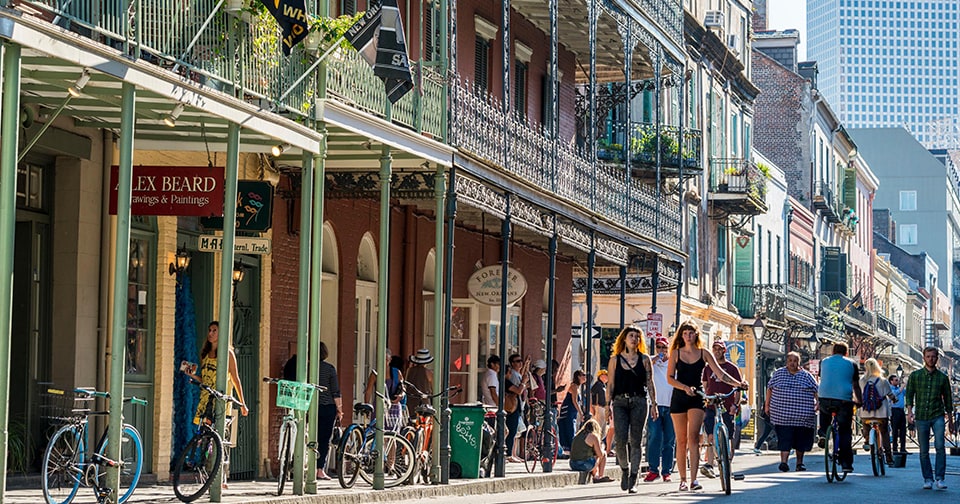
The city is also known as the Big Easy or NOLA. But if you call it New Orleans, locals will immediately spot you as an outsider. They drawl the name – it’s N’Awwwlins.
From its earliest days, this port city has embraced cultural diversity. Having been ruled by France and Spain in turns, then sold to the US in the Louisiana Purchase, the cuisine of this unique American state has happily encompassed all these influences. The final soupçon of flavor in the culinary melting pot came from African slaves brought here to work on the plantations.
All this might explain why this city of just 400,000 packs such a massive gastronomic punch. “Last year, there was only one city that had more James Beard Award nominees than New Orleans,” Kristian Sonnier, vice-president of communications with New Orleans & Co. tells me with pride. “That was New York – population eight million.”
It’s an extraordinary achievement considering the devastation wrought by Hurricane Katrina in 2005, which wiped out nearly a quarter of the restaurants in the city. Since then, the dining scene has taken a huge leap forward both in number of restaurants (which has more than doubled since 2006 to nearly 1,500) and the diversity of cuisines on offer.
Of course, Creole and Cajun have always been the defining culinary styles of Louisiana. Actually, characterizing these two is a little more difficult. Simplified, Creole is the cuisine of cities such as New Orleans, which enjoyed more cosmopolitan influences, so elements of Italian, Spanish, African, German, Caribbean, Native American, and Portuguese have become incorporated over the centuries. Indeed, Creole cuisine happily integrates exotic ingredients from a wide mix of cultures.
Being more cosmopolitan, Creole cuisine is usually considered to be slightly more highbrow. In fact, classic dining rooms such as Commander’s Palace, Galatoire’s, and Antoine’s, still have a dress code. In these, while there’s undoubtedly a French flavor to the menu, you’ll also find traditional Louisiana fare like gumbo, turtle soup, and Oysters Rockefeller (a dish first created at Antoine’s in 1889). Here too, a French classic like Canard à l’Orange might take on a distinctly Creole flavor profile, as it does at Commander’s Palace where it’s served with chili smoked boudin (a sausage of rice and meat), sherry glazed Brussels sprouts, satsuma marmalade, and Southern Comfort-persimmon jam.
Food of the people
One difference between Creole and Cajun is the roux. In deference to their French origins, Creole sauces always begin with a roux of butter and flour, whereas a Cajun roux consists of oil and flour.
The name Cajun derives from Acadian, the French settlers of Maritime Canada expelled by the British in the mid 18th century, during their war with the French. This group of resourceful immigrants used wild game, such as alligator, and the seafood of the Gulf of Mexico to create a unique cuisine.
Cajun, they will tell you, is the food of the people – spicy Andouille sausage and boudin, rich shrimp étouffée (stew), bubbling pots of okra-laced gumbo, and jambalaya (a variation on paella). A cook might begin a dish with a mirepoix, but the Cajun ‘holy trinity’ starts with onion, celery, and bell pepper rather than carrots. Tomatoes, an important part of Creole cuisine, rarely appear here. Indeed, the presence of tomatoes is a simple way of determining whether a jambalaya or gumbo is Cajun or Creole in origin.
At Cochon, Donald Link, an esteemed New Orleans restaurateur, created a place for sophisticated city-folk to try piquant, down-home, Cajun food. “We’re authentic, but we’re careful. Everything is seasoned well, but it’s not overly spicy,” explains Stephen Stryjewski, James Beard Award-winning chef and co-owner of Cochon. “We do the food you find in people’s homes – one-pot meals and authentic sausages.”
A taste of Vietnam
The city folk embraced it and Cochon, despite its casual style in a city that loves formal dining, is regularly included in top 10 lists of restaurants in New Orleans.
Historically, Creole and Cajun have so dominated the food scene that, until the 1970s, there were few distinctly ethnic restaurants in New Orleans. An influx of Vietnamese immigrants introduced the first really significant alternative.
Today, Vietnamese restaurants are ubiquitous and much loved. When Emeril Lagasse led a foodie tour of New Orleans, one of his key stops was Pho Tao Bay, a lauded Vietnamese eatery. And bánh mì, a traditional sandwich usually made with barbecued pork, is often described as the Vietnamese po’boy (the po’boy is a classic New Orleans sandwich).
“I grew up with Vietnamese friends, eating dinner at their homes,” says Michael Gulotta, twice a finalist for the James Beard Best Chef of the South Award. “There were Italian or French restaurants when I was a kid, but they were usually slightly Creole. The Vietnamese were the first restaurants here that didn’t modify themselves to be New Orleans.”
Gulotta, himself “a New Orleans mutt with Italian roots,” fell in love with the light pho broths and flavors, and the fresh ingredients of this cuisine, so he did what the Vietnamese didn’t. His first restaurant venture is the highly successful neighborhood eatery, MOPHO, serving his own blend of Cajun and Vietnamese. His second, slightly more upscale restaurant, Maypop, has taken the fusion to another level, with dishes such as traditional Louisiana oyster fritters topped with spicy pickled cucumbers and Manchego cheese, served on an unexpected reduction of Jack Daniels and soya sauce.
Different and new
Despite the Vietnamese breach of the gastronomic walls, and apart from the odd Indian, French or Thai incursion, New Orleans remained stubbornly faithful to the big two. But the last decade has seen a shift in the food scene. “Hospitality is the number one industry in New Orleans,” explains Alon Shaya, one of the first to breach the barrier. “But you have to be very good to try something different and new.”
Shaya opened Domenica in 2009 with then partner, John Besh. An unapologetically Italian restaurant, it was a huge success. But once he felt he had a strong relationship with his customers he embarked on his personal passion – his native Israeli cuisine. In 2015, Shaya was named James Beard Best Chef: South and the following year, his eponymous restaurant won the James Beard Award for Best New Restaurant.
Shaya restaurant continues under the Besh organization, but due to a falling out, its creator has left to open his own Middle Eastern concept – Saba – on trendy Magazine Street. And his fans have followed.
Party city
The menu at Saba includes his grandmother’s lutenitsa, a classic Bulgarian/Israeli red pepper, tomato and eggplant spread, which pairs perfectly with house-baked fluffy pita. But Saba’s menu takes a few creative detours with dishes such as hummus topped with roasted Brussels sprouts, chilies, caramelized onions and black garlic; or grilled octopus with shawarma spices and roasted tomatoes. Shaya’s expansion of the gastronomic boundaries has proved so successful, that there are now a number of Middle Eastern spots serving everything from fast food shawarma and falafel to traditional roast lamb.
Other chefs have widened the breach. St Lucia native, Nina Compton, was named James Beard Best Chef: South in 2018. Her restaurant Compère Lapin, incorporates Caribbean ingredients such as conch in a truly eclectic menu, reflecting her personal history as a chef in both French and Italian restaurants.
A visit to Havana really impressed Chris Hannah and Nick Dietrich. The bartending pair returned to New Orleans and launched a 24-seat bar and restaurant reflecting the heart and spirit they found in Cuba. Manolito has classic Cuban fare including rice and beans and Cuban sandwiches, but it’s Cuban cocktails like the Daiquiri and Mojito that have been winning accolades.
Cocktails are an important part of the scene in this party city. They have made Hot Tin, the bar atop the historic Pontchartrain Hotel, a popular gathering spot. Named for the Tennessee Williams’ novel, which he apparently wrote while in residence at the Pontchartrain, Hot Tin has become a Millennial Mecca.
In an effort to bring this group for dinner too, the Pontchartrain rebranded its restaurant. The new iteration, Jack Rose, under chef David Whitmore, has moved to a lighter Creole menu with dishes like Royal Red Shrimp Muddy Waters, serving the much prized crustaceans with squid ink campanelle. In the separate Living Room diners can enjoy a tapas-style menu of terrines, pâté, and light bites while relaxing on stuffed armchairs and sofas. It’s a long way from the formal (jackets required) Caribbean Room, which used to be the spot for locals to celebrate birthdays and graduations.
In just a decade the changes have been dramatic, but this city has proved its ability to adapt. Indeed, New Orleans has weathered both political and climatic changes and come out stronger
Liz Campbell




